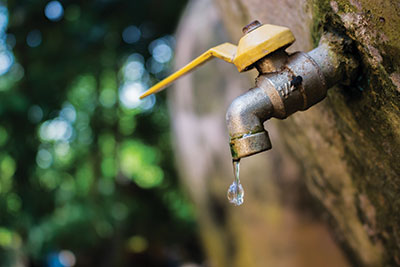 Partnerships among agencies that focus on efficient water management are more important than ever.
Partnerships among agencies that focus on efficient water management are more important than ever.
Water shortages continue to impact states throughout the country, a fact that Mary Ann Dickinson, president and CEO of the Alliance for Water Efficiency, says should concern everyone. Even states that are typically considered to be water rich are experiencing scarcity issues due to the stress of rapid population growth on a limited supply.
“We are experiencing shortages and rapid growth in areas where water is limited,” she says. “It is possible to stretch resources further and accommodate greater demand with the same supply, but that can only happen if water is managed well. Managing water efficiently is a real opportunity.”
Because of these issues, programs like the U.S. Environmental Protection Agency’s (EPA) WaterSense and Smart Water Application Technologies (SWAT), which focus on efficient water management, are as important as ever. A June Irrigation Association (IA) webinar invited Dickinson and representatives from WaterSense and SWAT to compare the programs and discuss the roles they play in the irrigation industry.
Founded in 2002, SWAT is an international initiative to achieve efficient landscape water use through the application of irrigation technology. SWAT identifies, researches and promotes technological innovations and related management practices that advance the principles of efficient water use. Led by the IA in partnership with leading water purveyors, SWAT also includes industry associations and irrigation equipment suppliers.
“SWAT was really the first time groups like utilities, manufacturers and distributors joined together on a water initiative,” says Robert Reaves, member of the SWAT Executive Task Team and water conservation coordinator for Oklahoma City, Okla. “We develop testing protocols to see if products actually work.”
Eye on swat
SWAT formulates performance testing plans for different categories of irrigation products. These protocols define scientific methods to evaluate whether products meet established standards for water-use efficiency. Protocols are drafted by irrigation experts, then opened for public comment before being revised and adopted. Once finalized, SWAT protocols are used by third-party testing agencies to evaluate whether irrigation products submitted by manufacturers actually save water. Many water providers use these test results as the basis for offering rebates and incentives to consumers who are upgrading their sprinkler systems.
In addition to developing test protocols and reports, SWAT defines best practices for irrigation and water management and encourages partnerships between water providers, irrigation industry members, government agencies and landscape professionals. SWAT also educates stakeholders about the water-saving potential of advanced irrigation technologies and produces professional, customizable marketing materials for water providers to use in contractor and customer outreach programs.
“In the future we will continue to look for more ways technology is changing things,” Reaves says. “It’s very important for us to combine regional resources to enhance the reach of SWAT and provide unbiased information about smart irrigation technology.”
Watersense’s focus
While SWAT provides product testing results to the public, WaterSense, a program sponsored by the EPA, uses testing data to certify products that meet certain requirements. The organization, which celebrated its 10th anniversary in 2016, partners with manufacturers, retailers, distributors, home builders, irrigation professionals and utilities to bring WaterSense concepts to communities throughout the country. WaterSense-labeled products and services are certified to use at least 20 percent less water, save energy and perform as well as or better than regular models. In many cases, WaterSense uses SWAT protocols to develop standards for product labeling.
“We are always emphasizing performance. We don’t want a more efficient toilet if it doesn’t work,” says Veronica Blette, WaterSense program chief. “The work SWAT does is very helpful in providing us the information we need to move forward.”
To certify a product, WaterSense issues a notice of intent (NOI) to inform the public that it intends to carry out work to develop a specification. The NOI also describes additional data needs or questions that need to be answered before a draft specification is developed. The program may make the decision to hold off on developing a specification to allow for additional research. Draft specifications are released for public review and comment before being issued as final specifications.
While many WaterSense-certified products relate to the indoor plumbing industry, the organization is beginning to focus more efforts on outdoor irrigation products. The number of WaterSense-certified weather-based irrigation controllers has doubled since last year, Blette says, and the organization is currently working on certifying several other irrigation products. For example, WaterSense released draft specifications for sprinkler bodies last fall, and it issued a notice of intent for soil-moisture-based technologies in May 2013.
“We hope we’ll have a good protocol by the end of this summer,” Blette says of soil-moisture-based technologies, adding that this has been a particularly challenging product category to work with. “We believe there are really good (water) savings that can be seen here.”
WaterSense promotes water sustainability efforts beyond just products and parts. The organization also supports the practice of planting the right plants in the right places and encourages all irrigation contractors to be professionally certified.
“It’s not just about irrigation—there are ways to plant, maintain and develop a landscape that will impact water use,” Blette says. “What we see is that people don’t understand how much water they really use, and they need the right information to tell them what to do. Landscape professionals can help to respond to homeowner questions and needs by providing information and to bridge the gap to also get that information to municipalities.”
Photo: ©istock.com/R_Tee


